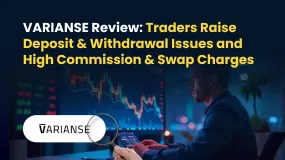简体中文
繁體中文
English
Pусский
日本語
ภาษาไทย
Tiếng Việt
Bahasa Indonesia
Español
हिन्दी
Filippiiniläinen
Français
Deutsch
Português
Türkçe
한국어
العربية
Three Reasons Why US Markets Thrive in Prolonged Fed Hold
Abstract:The surprising resilience of US financial markets under prolonged high Fed rates reveals three unique factors mitigating systemic risks.

The US financial markets have exhibited astonishing resilience in the face of the Federal Reserve's most prolonged period of high interest rates in more than four decades, in an extraordinary turn of events. Markets are proceeding without substantial disruptions, despite concerns that these “restrictive” policies, as Chair Jerome Powell has referred to them, could potentially undermine the economy. The following are three critical factors that elucidate the difference between this period and others, as well as how these elements contribute to a stable financial landscape.
1. The Privatization of Risk
The financial ecosystem has undergone a substantial transformation to the extent that risk is increasingly privatized. In contrast to the public market collapses of 2000 and 2007, which were visible to all and precipitated widespread hysteria, a significant portion of today's financing takes place in the shadows. Private entities, including pension funds, endowments, family offices, and ultra-wealthy individuals, are now more prominently involved in lending, circumventing the stricter regulations that govern public financial institutions.
This trend indicates that the likelihood of immediate contagion regarding prospective issues within the financial system is reduced. For instance, herd behavior that frequently results in market collapses is prevented by the fact that missed interest payments by private entities do not generate public headlines. Additionally, the risk of precipitous financing stops is mitigated by the relatively low likelihood of investors in private credit funds, including pension funds and insurance companies, to abruptly terminate their investments.
Nevertheless, this privatization is not without its own set of associated hazards. The potential for lower underwriting standards and the opacity of the private credit market has been emphasized by the International Monetary Fund (IMF) in response to the increased pressure to finalize transactions. In the event of a substantial market decline, there are concerns regarding the “layers of leverage” that exist within this ecosystem, which could potentially compound disruptions.
2. The Growth-Powered Government Debt
An additional distinctive feature of the current financial stability is the function of government debt in driving economic growth. Federal spending is a substantial contributor to the current period, in contrast to previous expansions that were fueled by corporate or household borrowing. In 2023, government expenditure was the primary source of GDP growth, with the highest percentage in over a decade, primarily funded by debt.

Inherently less hazardous than private debt, government debt is generally regarded as secure due to the federal government's capacity to tax. Unfortunately, the costs of this borrowing are on the rise, and there are concerns regarding the fiscal trajectory's sustainability. Although these concerns are valid, it does not appear that the current level of debt has yet reached a critical threshold that would result in a substantial increase in yields and the destabilization of the economy.
3. Fed's Balanced Approach
Maintaining market stability has also been significantly influenced by the Federal Reserve's strategy for managing elevated interest rates. Despite the fact that the Federal Reserve has implemented vigorous rate hikes and reduced its bond portfolio, it continues to exhibit a high degree of sensitivity to potential negative outcomes. Exemplifying this vigilance is the central bank's prompt intervention during the collapse of Silicon Valley Bank in March 2023.
Strategic communication by the Federal Reserve has been instrumental in mitigating market volatility and ameliorating financial conditions. This has necessitated a meticulous equilibrium: the preservation of a “tight” monetary policy while preventing the economy from spiraling into recession. In spite of the elevated interest rates, the Federal Reserve's interventions and signaling have maintained relatively benign financial conditions, thereby averting substantial fluctuations.
In spite of this, the Federal Reserve's capacity to oversee all facets of the financial system is restricted. Particularly in sectors with less regulatory supervision, such as fintech lending, and among low-income households, high interest rates have generated tension. Prolonged high rates have yet to completely test the resilience of the broader financial system and consumer markets.

In summary,
To conclude, the current stability of the US financial markets, despite the protracted high interest rates, can be attributed to a combination of factors. Within the opaque domains of private credit markets, the privatization of risk has served to mitigate potential contagions. Government debt has been instrumental in maintaining economic expansion, despite the increasing apprehensions regarding fiscal sustainability. Finally, the Federal Reserve's strategic communication and balanced approach have facilitated the management of market expectations and the diminution of potential downturns. Although these components have thus far maintained market stability, the inherent risks and potential stress points indicate that it is imperative to exercise caution when navigating this unprecedented economic environment.
You may access the financial latest news here.

Disclaimer:
The views in this article only represent the author's personal views, and do not constitute investment advice on this platform. This platform does not guarantee the accuracy, completeness and timeliness of the information in the article, and will not be liable for any loss caused by the use of or reliance on the information in the article.
Read more

WikiEXPO Dubai “Welcome Party” Concludes Successfully, Setting the Stage for the Main Event!
On the evening of November 10, 2025, the highly anticipated WikiEXPO Dubai “Welcome Party” was successfully held at the 6th Floor, Conrad Dubai, UAE. Serving as a “prelude” to the official opening of the expo, this event provided a high-end yet relaxed communication platform for representatives of global regulatory bodies, leaders of Fintech companies, renowned brokers, and senior executives of investment institutions.

VARIANSE Review: Traders Raise Deposit & Withdrawal Issues and High Commission & Swap Charges
Are you losing both while depositing and withdrawing your capital at VARIANSE? Does the broker give the currency conversion rate excuse for this? Have you been trapped with spreads charged higher than promised? Do you bear steep commission and swap charges at this broker? Traders frequently report these trading issues online. In today’s VARIANSE broker review, we have shared some trading complaints that have grabbed everyone’s attention. Take a look.

WikiEXPO Dubai 2025 “Welcome Party” Kicks Off Tonight!
In anticipation of the upcoming WikiEXPO Dubai 2025, the WikiEXPO Organizing Committee has specially arranged a high-end social gathering—the “Welcome Party”. The event will be grandly held on the evening of Monday, Nov 10, on the 6th Floor, Conrad Dubai, UAE.

WikiEXPO Dubai 2025, a Global Fintech Expo, Is About to Commence
One of the world’s largest Fintech expos, WikiEXPO Dubai 2025, hosted by WikiGlobal and co-organized by WikiFX, will grandly open at the Millennium Plaza Downtown Hotel in Dubai on November 11, 2025. This event is expected to attract over 5,000 participants and 200+ partners from around the globe to discuss global trends in financial innovation and digital transformation.
WikiFX Broker
Latest News
BASF CEO: EU CO₂ Trading Is A "Destruction Mechanism" For European Industry
Is Fyntura a Regulated Broker? A Complete 2025 Broker Review
PINAKINE Broker India Review 2025: A Complete Guide to Safety and Services
Is Inzo Broker Safe or a Scam? An Evidence-Based Analysis for Traders
Is Uniglobe Markets Legit? A 2025 Simple Guide to Its Safety, Services, and User Warnings
Is Forex Zone Trading Regulated and Licensed?
WikiEXPO Dubai 2025 “Welcome Party” Kicks Off Tonight!
He Trusted a WhatsApp Group and Lost RM659,000
Exness Restricted Countries List 2025 Explained
Zetradex Exposed: Withdrawal Denials, Account Freeze & Bonus Issues Hurt Traders
Currency Calculator



